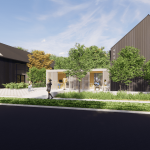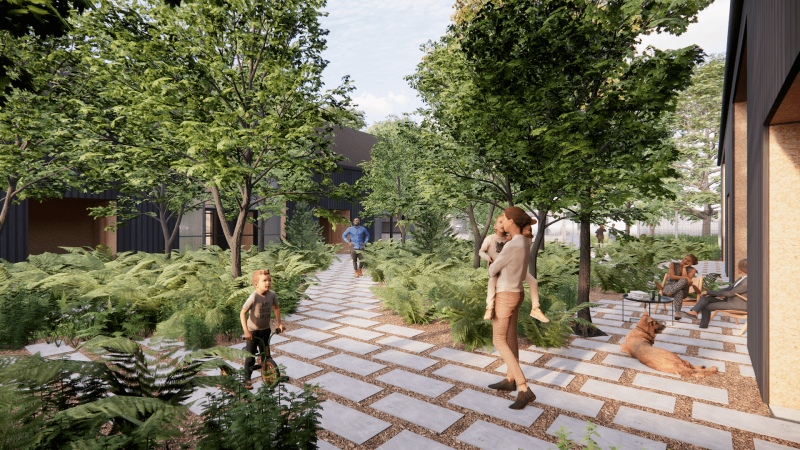An architect taking on the additional roles of developer and investor is a fairly novel idea. And a woman working as a real estate developer is still a unique role.
Because – service-based by nature – architects typically don’t take a stake on the other side of the table, while women make up just 34% of all real estate developers.
But Michelle Kleinman and Chelsea Hyduk are breaking both molds and forging into these new territories together with a clear vision and very personal approach with their new project in Core City, Detroit.

RENDERING OF CORE CITY DEVELOPMENT
“Architects wear so many hats it’s both daunting & invigorating to consider taking on the role of developer within a project. We are investing personally in our work which provides many benefits: a deeper understanding of financing, managing contractors, the overall life cycle of a project, and financial returns,” said Hyduk.
Michelle adds, “Wearing both hats allows us, as stakeholders, to prioritize values that sometimes don’t get executed in the final completion of a project otherwise. Being a stakeholder allows us to see our vision through and make sure that the values that are important to us – building a community, landscape, sustainability, a smaller footprint, a unique vision for shared spaces – remain viable in the realization of the project.”
The women attended grad school together at Columbia University in New York City. With a strong shared desire to do their own work, create a certain lifestyle and do what they say is ‘important and meaningful to them,’ a few years ago they moved to Detroit, bought four lots in Core City, and got to work planning a multifamily residential project that will support indoor and outdoor amenity space intended to facilitate community use.
When asked why Core City, Kleinman says,
There is a really unique type of development going on here that’s community focused. The people and developers are open to new ideas and are building a sense of place. There is power in collaborating with others to create our own community the way the residents and stakeholders want.
Hyduk adds, “The balance between landscape and development in Core City feels very true to what Detroit wants to be. It is not meant to be another New York or Chicago – Detroit has a DNA that is truly unique to the Midwest.”

CHELSEA HYDUK
Regarding the project, these partners are all in. Literally. They currently reside in Core City and plan to take up residence within their final product, slated to be complete in 2024.
“As we are designing, we are envisioning ourselves living in the units, along with others,” said Kleiman. “Incorporating our personal vision makes it more specific, thoughtful, personal, and unique.”
They are also designing with the concept of creating a smaller footprint to allow for more community-oriented space.
“We are essentially removing some of the amenities from each unit and creating shared amenity spaces to extend their usage, foster community and reduce the amount of building,” said Hyduk.
To that end, the design includes what they call ‘shared amenity sheds.’ The duo envisions them being used for such things as a wood shop, a community greenhouse or even shared workspaces.
We see a lot of beauty in living, working and playing together. So instead of a backyard with a fence, we see an amazing shared space to grow, create and work alongside your neighbors and also learn from one another. This expands the residential footprint far beyond its four walls, says Kleinman.

MICHELLE KLEINMAN
Another aspect that’s important to them is generational sustainability.
“Talking to twenty-somethings who live downtown and hearing things like ‘I’m having kids so I need move to the suburbs, is driving us to think differently,” said Hyduk.
So we are thinking about how we can create a sustainable neighborhood by incorporating everyone, facilitating family old and young. A neighborhood that can evolve.
And circling back to the fact that female developers are in short order, Kleinman and Hyduk believe

CORE CITY DEVELOPMENT RENDERING
that layering in a female perspective brings diversity and growth to how things are designed. That collage that can happen when different people come together and collaborate is always better than a single perspective is a principal they believe in.
Do they think this model of architects taking financial and development stake in projects might expand? They lean toward saying no, although Kleinman adds, “I do hope it’s considered, I think every architect should find a way to take agency in their work because the outcome will be more powerful .”
In terms of the challenges, both women point to the cost of materials. Also, when it comes to navigating the city and different groups and processes, they both say there is quite a learning curve. Not to mention, both women have full-time jobs.
But for now, they wouldn’t have it any other way.
Hyduk adds, “We are using this as a test model that we hope to grow and develop. We look forward to keeping our values intact and executing on them to develop unique, sustainable, community-forward, and comfortable spaces for people to live and thrive within. We want that for ourselves, and the neighborhoods throughout Detroit.”
As always, be sure to subscribe to our newsletter for regular updates on all things Detroit.























